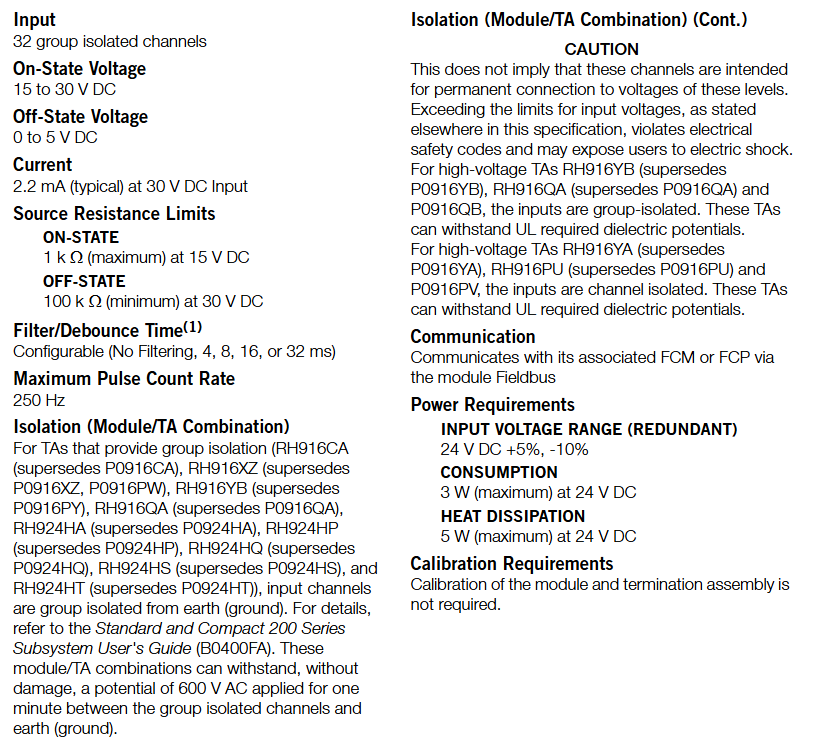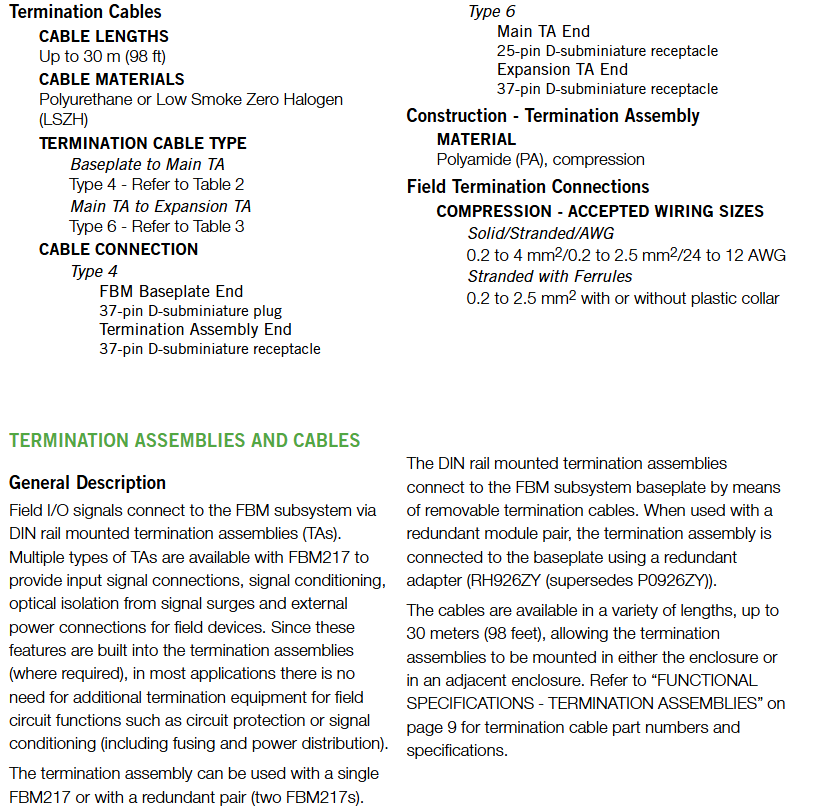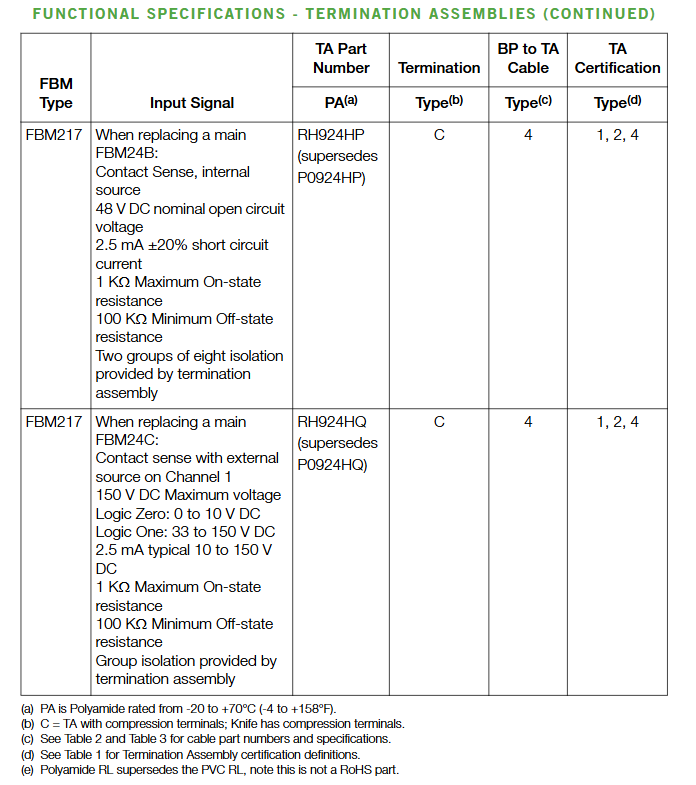

K-WANG


Foxboro Evo FBM217 Discrete Input Module
Foxboro Evo FBM217 Discrete Input Module
Core functions and features of the module
FBM217 is a 32 channel discrete input module designed specifically for industrial environments, supporting multi voltage level signal acquisition and high reliability operation. Its core functions and features are as follows:
(1) Core functions
Multi voltage signal support: covering low, medium, and high voltage inputs, including:
Low voltage: 15~60V DC (voltage monitoring or contact detection);
Medium voltage: 120V AC/125V DC (logic 0:0~20V AC/DC, logic 1:80~132V AC/75~150V DC);
High voltage: 240V AC (logic 0:0~40V AC, logic 1:164~264V AC).
Redundancy deployment capability: Supports single module or redundant paired deployment (2 FBM217s need to be installed in adjacent odd/even positions on the base, with the redundant adapter RH926ZY). In redundancy mode, the input signal quality is verified through the CINR function block of Foxboro Evo control software, and the optimal signal is automatically selected.
Event Sequence (SOE) Function: In conjunction with I/A Series v8. x and above software or Control Core Services v9.0+, supports event collection, storage, and reporting, with optional GPS time synchronization (accuracy up to 1ms); The old version software (before v8. x) needs to be implemented through the ECB6/EVENT block, with an accuracy of 1 second and no cross processor synchronization.
Signal conditioning and protection: relying on termination components (TAs) to achieve optical isolation, current limitation, and voltage attenuation. Some TAs support external excitation power supply access without the need for additional on-site circuit protection equipment (such as fuses).
(2) Key characteristics
Environmental adaptability: Complies with ISA S71.04 G3 level harsh environmental standards, can withstand vibration (0.75 m/S ² @ 5-500Hz), wide temperature range (working -20~70 ℃, storage -40~70 ℃);
Hot swappable design: When replacing modules, there is no need to remove on-site wiring, power or communication cables. The replacement of redundant modules does not affect the on-site signal acquisition of normal modules;
Status indication: The front LED light provides real-time feedback on the operating status of the module (such as fault, ready) and the discrete status of a single input channel, facilitating quick diagnosis;
Communication reliability: Connected to the Fieldbus Communication Module (FCM) or Control Processor (FCP) via a 2 Mbps module fieldbus, supporting A/B dual path communication and automatic switching in case of single path failure.

Hardware parameters and technical specifications
(1) Input and electrical parameters
Parameter category specific specifications
Channel configuration with 32 isolated channels (isolation level dependent on TA, some TAs support channel level isolation)
Typical 2.2mA at 30V DC input current; maximum 2.8mA at high voltage (240V AC) (logic 1 state)
Source resistance limit logic 1 (15V DC) ≤ 1k Ω; logic 0 (30V DC) ≥ 100k Ω
The filtering/debounce time can be configured (no filtering, 4ms, 8ms, 16ms, 32ms, firmware v1.25H+required)
Maximum pulse counting rate 250Hz
The combination of isolation voltage module and TA can withstand 600V AC (1 minute, group isolation channel to ground)
(2) Power supply and power consumption
Power input: 24V DC (redundant mode, allowable range+5%/-10%, i.e. 21.6-26.4V DC);
Power consumption: maximum 3W at 24V DC (operation), maximum heat dissipation 5W;
Power protection: Supports redundant independent DC power supply access to enhance power supply reliability.
(3) Physical and environmental parameters
Parameter category specification requirements
Dimensions (module) Height 102mm (including installation ears 114mm) x Width 45mm x Depth 104mm
The weight module weighs approximately 284g (10oz); TA approximately 420-454g (0.93-1.0lb)
Working environment temperature -20~70 ℃, humidity 5%~95% (non condensing), altitude -300~3000m
Storage environment temperature -40~70 ℃, humidity 5%~95% (no condensation), altitude -300~12000m
The pollution level complies with EIA 364-65 Class III and is suitable for harsh environments of ISA S71.04 G3 level
Installation and Termination Component (TA) Configuration
FBM217 needs to be used in conjunction with a dedicated base and termination assembly (TA), and installation and wiring must follow strict specifications. The core requirements are as follows:
(1) Base and installation
Base type: Modular base (DIN rail or 19 inch rack mounted), with a maximum capacity of 4 or 8 FBM modules per base;
Redundant modules need to be installed in adjacent odd/even positions (such as 1&2, 3&4) and connected through redundant adapter RH926ZY;
Support 100 series conversion installation structure (refer to PSS 31H-2W8) for easy upgrading of old systems.
Installation specifications:
DIN rail: Supports 32mm/35mm specifications, with priority given to galvanized yellow chromium steel material (ensuring good grounding), fixed at a spacing of approximately 200mm;
Panel installation: Use M4 or # 8 screws and reserve heat dissipation space (≥ 25mm on each side of the module).
(2) Termination Component (TA) Selection
TA is the core component connecting FBM217 with on-site signals, providing signal conditioning, isolation, and power distribution functions. It needs to be selected according to the input signal type. Common TA and adaptation scenarios are as follows:
TA model adaptation signal type isolation level certification type
RH916CA (main TA) 30V DC voltage monitoring, 32 channel group isolation Type 1/2/4
RH916XZ (main TA) 24V DC contact detection, 32 channel group isolation Type 1/2/4
RH916YA (main TA) 132V AC/150V DC voltage monitoring, 32 channel isolation Type 1/4
RH916PU (main TA) 240V AC voltage monitoring, 32 channel isolation Type 1
RH924HB (Extended TA) replaces FBM12A/B expansion module, 16 channel group isolation Type 1/2/4
RH924HD (Extended TA) replaces FBM13 expansion module, 16 channel isolation Type 1/4
TA connection: The main TA is connected to the base through a Type 4 cable (37 pin D-sub interface), and the extended TA is cascaded through a Type 6 cable (main TA 25 pin → extended TA 37 pin), with a maximum cable length of 30m, supporting P/PVC or LSZH materials (LSZH is suitable for low smoke and halogen-free scenarios);
Upgrade adaptation: When replacing the 100 series FBM (such as FBM07A/B, FBM08, FBM20), it is necessary to match the corresponding main TA+extended TA (such as replacing FBM07A with RH924HA main TA+RH924HB extended TA).

Compliance certification and security requirements
(1) Core certification
The FBM217 module and its supporting TA comply with global safety and electromagnetic compatibility standards in multiple regions, with the following core certifications:
Specific standards and levels for certification categories
Hazardous Area Certification North America: UL/UL-C Class I Division 2 Groups A-D, Temperature Code T4;
Europe: ATEX 2014/34/EU II 3 G Ex nA IIC T4 (DEMKO certification);
International: IECEx Ex nA IIC T4, certificate number refers to relevant TA documents
Electromagnetic compatibility (EMC) complies with EN 61326-1:2013 Class A (Emission and Immunity in Industrial Environments), EU EMC Directive 2014/30/EU
Low voltage safety EU Low Voltage Directive 2014/35/EU, in compliance with EN 61131-2 standard; UL Class 2 Circuit (Communication Circuit)
Environmental compliance complies with the EU RoHS 2011/65/EU directive, restricting the use of hazardous substances
Ship certification ABS type approval, French Classification Society (BV) EC31 environmental category certification
(2) Safety operation requirements
Electrical safety:
On site wiring must comply with Class 2 circuit restrictions (60V DC/30V AC, below 100VA), and high voltage TA must avoid long-term overvoltage operation (such as prohibiting the connection of signals above 300V AC to 240V AC modules);
Grounding requirements: The base is grounded through a DIN rail, and the use of aluminum/plastic rails is prohibited (which may cause poor grounding). The TA isolation channel needs to be grounded separately.
Dangerous area operation:
It needs to be installed in a certified enclosure with a protection level of IP54 or higher, and the enclosure needs to be opened with tools;
Before connecting/disconnecting cables, power off or confirm that the area is in a non hazardous environment. Replacement of non certified components is prohibited.
Upgrade and compatibility instructions
FBM217 is mainly used to replace Foxboro 100 series discrete input FBM modules. When upgrading, the following compatibility points should be noted:
Hardware replacement: A single FBM217 can replace one 100 series main FBM (such as FBM07A/B, FBM08)+one extended FBM (such as FBM12, FBM13), which needs to be matched with the corresponding functional main TA and extended TA (refer to the document "TA Selection Table for Migration");
Software adaptation:
New system: requires Studio 5000 or Foxboro Evo control software v8. x+, supporting redundant CINR blocks and GPS SOE synchronization;
Old system: 100 series upgrade can use termination component adapter (TAA, refer to PSS 31H-2W4) without rewiring;
Cable Reuse: Some 100 series on-site cables can be adapted to FBM217 through TAA, but the voltage level and TA compatibility need to be confirmed.

- YOKOGAWA
- Energy Access
- Renewable Integration
- Energy Subsidies
- Energy and Water
- Net zero emission
- Energy Security
- Critical Minerals
- A-B
- petroleum
- Mine scale
- Energy and Gender
- Covid-19
- man-machine
- Reliance
- ADVANCED
- SEW
- ProSoft
- WATLOW
- Kongsberg
- FANUC
- VSD
- DCS
- PLC
- Sewage treatment
- cement
- Yaskawa
- Woodward
- BOSCH Rexroth
- MOOG
- General Electric
- American NI
- Rolls-Royce
- CTI
- Honeywell
- EMERSON
- Automobile market
- xYCOM
- Motorola
- architecture
- Industrial information
- New energy
- electricity
- Construction site
- HIMA
- ABB
- Rockwell
- Schneider Modicon
- Siemens
- MAN
- GE
- TRICONEX
- Control Wave
- ALSTOM
- AMAT
- STUDER
- KONGSBERG
- MOTOROLA
- DANAHER MOTION
- Bentley
- Galil
- EATON
- MOLEX
- Triconex
- DEIF
- B&W
- ZYGO
- Aerotech
- DANFOSS
- KOLLMORGEN
- Beijer
- Endress+Hauser
- schneider
- Foxboro
- KB
- REXROTH
- YAMAHA
- Johnson
- Westinghouse
- WAGO
- TOSHIBA
- TEKTRONIX
-
GE Hydran M2-X Enhanced Monitoring
-
ABB REG316 1mrk000809-GA Numerical Generator Protection
-
ABB RED670 1MRK004810 Line differential protection
-
GE SR750-P5-G5-S5-HI-A20-R-E Feeder protection system
-
ABB PFTL301E-1.0KN 3BSE019050R1000 PillowBlock Load cells
-
Kollmorgen S33GNNA-RNNM-00 - Brushless Servo Motor
-
Kollmorgen 6sm56-s3000-g-s3-1325 - Servo Motor
-
Kollmorgen AKM52K-CCCN2-00 - Servo Motor
-
Kollmorgen PSR3-230/75-21-202 - Power Supply
-
Kollmorgen akm24d-anc2r-00 - Servo Motor
-
Kollmorgen AKM22E-ANCNR-00 - Servo Motor
-
Kollmorgen S60300-550 - Servo Drive
-
Kollmorgen B-204-B-21 - Servomotor
-
Kollmorgen AKM21E-BNBN1-00 - Servo Motor
-
Kollmorgen TT2953-1010-B - DC Servo Motor
-
Kollmorgen pa8500 - Servo Power Supply
-
Kollmorgen BDS4A-210J-0001-207C2 - Servo Drive
-
Kollmorgen TTRB1-4234-3064-AA - DC Servo Motor
-
Kollmorgen MH-827-A-43 - Servo Motor
-
Kollmorgen AKM24D-ACBNR-OO - Servo Motor
-
Kollmorgen 00-01207-002 - Servo Disk DC Motor
-
Kollmorgen AKM21C-ANBNAB-00 - Servo Motor
-
Kollmorgen PSR3-208/50-01-003 - Power Supply
-
Kollmorgen 6SM56-S3000 - Servo Motor
-
Kollmorgen DBL3H00130-B3M-000-S40 - Servo Motor
-
Kollmorgen 6SN37L-4000 - Servo Motor
-
Kollmorgen AKM65K-ACCNR-00 - Servo motor
-
Kollmorgen 6SM56-L3000-G - Servo Motor
-
Kollmorgen AKMH43H-CCCNRE5K - Servo Motor
-
Kollmorgen PSR4/52858300 - Power Supply
-
Kollmorgen KBM-79H03-E03 - Direct Drive Rotary Motor
-
Kollmorgen AKM33E-ANCNDA00 - Servo Motor
-
Kollmorgen U9M4/9FA4T/M23 - ServoDisc DC Motor
-
Kollmorgen AKM13C-ANCNR-00 - Servo Motor
-
Kollmorgen AKM43L-ACD2CA00 - Servo Motor
-
Kollmorgen AKM54K-CCCN2-00 - Servo Motor
-
Kollmorgen M-605-B-B1-B3 - Servo Motor
-
Kollmorgen AKD-P00606-NBAN-0000 - Rotary Drive
-
Kollmorgen 6SM-37M-6.000 - Servo Motor
-
Kollmorgen A.F.031.5 - Sercos Interface Board
-
Kollmorgen 918974 5054 - Servo PWM
-
Kollmorgen U12M4 - ServoDisc DC Motor
-
Kollmorgen AKD-B00606-NBAN-0000 - Servo Drive
-
Kollmorgen MV65WKS-CE310/22PB - Servo Drive
-
Kollmorgen 65WKS-CE310/22PB - Servo Drive
-
Kollmorgen EM10-27 - Module
-
Kollmorgen S64001 - Servo Drive
-
Kollmorgen CR03200-000000 - Servo Drive
-
Kollmorgen 6SM57M-3000+G - Servo Motor
-
Kollmorgen BDS4 - Servo Drive
-
Kollmorgen AKD-P00306-NBEC-000 - Servo Drive
-
Kollmorgen AKD-B01206-NBAN-0000 - Servo Drive
-
Kollmorgen STP-57D301 - Stepper Motor
-
Kollmorgen 6SM37L-4.000 - Servo Motor
-
Kollmorgen 44-10193-001 - Circuit Board
-
Kollmorgen PRDR9SP24SHA-12 - Board
-
Kollmorgen PRD-AMPE25EA-00 - Servo Drive
-
Kollmorgen DBL3N00130-0R2-000-S40 - Servo Motor
-
Kollmorgen S406BA-SE - Servo Drive
-
Kollmorgen AKD-P00607-NBEI-0000 - Servo Drive
-
Kollmorgen AKD-P01207-NBEC-0000 - Servo Drive
-
Kollmorgen CR03550 - Servo Drive
-
Kollmorgen VSA24-0012/1804J-20-042E - Servo Drive
-
Kollmorgen N2-AKM23D-B2C-10L-5B-4-MF1-FT1E-C0 - Actuator
-
Kollmorgen 04S-M60/12-PB - Servo Drive
-
Kollmorgen H33NLHP-LNW-NS50 - Stepper Motor
-
Kollmorgen A-78771 - Interlock Board
-
Kollmorgen AKM43E-SSSSS-06 - Servo Motor
-
Kollmorgen AKD-P00607-NBEC-0000 - Servo Drive
-
Kollmorgen E21NCHT-LNN-NS-00 - Stepper Motor
-
Kollmorgen cr10704 - Servo Drive
-
Kollmorgen d101a-93-1215-001 - Motor
-
Kollmorgen BDS4A-203J-0001-EB202B21P - Servo Drive
-
Kollmorgen MCSS23-6432-002 - Connector
-
Kollmorgen AKD-P01207-NACC-D065 - Servo Drive
-
Kollmorgen CK-S200-IP-AC-TB - I/O Adapter and Connector
-
Kollmorgen CR10260 - Servo Drive
-
Kollmorgen EC3-AKM42G-C2R-70-04A-200-MP2-FC2-C0 - Actuator
-
Kollmorgen BDS5A-206-01010-205B2-030 - Servo Drive
-
Kollmorgen s2350-vts - Servo Drive
-
Kollmorgen AKM24D-ANC2DB-00 - Servo Motor
-
Kollmorgen E31NCHT-LNN-NS-01 - Stepper Motor
-
Kollmorgen PRD-0051AMPF-Y0 - Servo Board
-
Kollmorgen TB03500 - Module
-
Kollmorgen 60WKS-M240/06-PB - Servo Drive
-
Kollmorgen M21NRXC-LNN-NS-00 - Stepper Motor
-
Kollmorgen H-344H-0212 - Servo Motor
-
Kollmorgen MCSS08-3232-001 - Connector
-
Kollmorgen AKM33H-ANCNC-00 - Servo Motor
-
Kollmorgen PA-2800 - Power Supply
-
Kollmorgen MTC308C1-R1C1 - Servo Motor
-
Kollmorgen PRDR0091300Z-00 - Capacitor Board
-
Kollmorgen BDS4A-206J-0024/01502D79 - Servo Drive
-
Kollmorgen S20330-VTS - Servo Drive
-
Kollmorgen S20250-CNS - Servo Drive
-
Kollmorgen SBD2-20-1105-WO - Servo Drive Board
-
Kollmorgen M405-C-A1--E1 - Servo Motor
-
Kollmorgen PRD-PB805EDD-00 - Servo Drive
-
Kollmorgen 6SM57S-3.000-J-09-HA-IN - Servo Motor
-
Kollmorgen AKM33H-ANCNDA-00 - Servo Motor
-
Kollmorgen PCB-00030200-04 - PCB
-
Kollmorgen H22SSLB-LNN-NS-02 - Stepper Motor
-
Kollmorgen BJRL-20012-110001 - Module
-
Kollmorgen BDS4A-206J-0001404A - Servo Drive
-
Kollmorgen H-342-H-0802 - Servo Motor
-
Kollmorgen CR10561 - Servo Drive
-
Kollmorgen BDS5A-206-00010-205B2-030 - Servo Drive
-
Kollmorgen BDS5A-206-00010-207B-2-030 - Servo Drive
-
Kollmorgen mcss08-3224-001 - Connector
-
Kollmorgen M-207-B-23-B3 - Servo Motor
-
Kollmorgen PRD-0041200Z-S0 - Encoder/Resolver Card
-
Kollmorgen MH-225-G-61 - Motor
-
Kollmorgen MT308B1-T1C1 - Servo Motor
-
Kollmorgen BDS4A-240J-0001604C83 - Servo Drive
-
Kollmorgen 6SM57-S-3000 - Servo Motor
-
Kollmorgen N-T31V-15-5B-6-MF3-FT1E-C251 - Actuator
-
Kollmorgen PRD-0051AMPA-X0 - Servo Board
-
Kollmorgen CF-SS-RHGE-09 - Cable
-
Kollmorgen DIGIFAS7204 - Servo Drive
-
Kollmorgen S30101-NA - Servo Drive
-
Kollmorgen DIGIFAS7201 - Servo Drive
-
Kollmorgen PRD-0051AMPA-Y0 - Servo Board
-
Kollmorgen AKM23D-EFCNC-00 - Servo Motor
-
Kollmorgen SE10000 - Servo Drive
-
Kollmorgen PSR4/5A-112-0400 - Power Supply
-
Kollmorgen AKM31H-ANCNC-01 - Servo Motor
-
Kollmorgen M-203-B-93-027 - Servo Motor
-
Kollmorgen CP-SS-G1HE-05 - Connector




